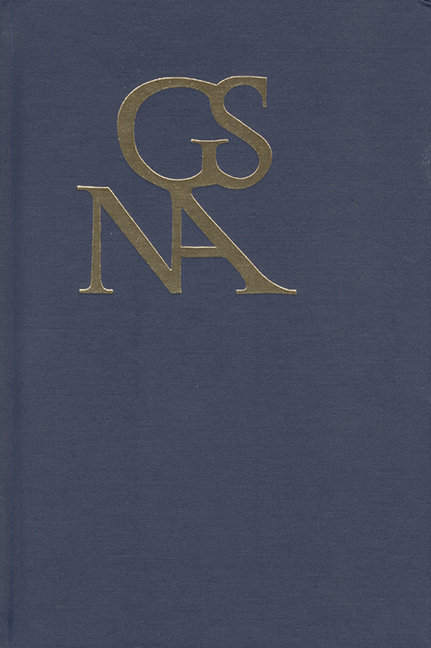Book contents
- Frontmatter
- Contents
- Special Section on What Goethe Heard, edited by Mary Helen Dupree
- What Goethe Heard: Special Section on Hearing and Listening in the Long Eighteenth Century
- Behind Herder's Tympanum: Sound and Physiological Aesthetics, 1800/1900
- Becoming the Listener: Goethe's “Der Fischer”
- Of Barks and Bird Song: Listening in on the Forgotten in Ludwig Tieck's Der blonde Eckbert
- Garden Empire or the Sublime Politics of the Chinese-Gothic Style
- Die Austreibung des Populären: Schillers Bürger-Kritik
- Goethe and the Uncontrollable Business of Appropriative Stage Sequels
- Repetition and Textual Transmission: The Gothic Motif in Goethe's Faust and “Von deutscher Baukunst”
- “Die gewalt'ge Heldenbrust”: Gender and Violence in Goethe's Iphigenie auf Tauris
- Literary Form and International World Order in Goethe: From Iphigenie to Pandora
- Two Gifts from Goethe: Charlotte von Stein's and Charlotte Schiller's Writing Tables
- Goethe's Wilhelm Meister and the Refusal to Grow Up: The Dialectics of Bildung
- “So steh' ich denn hier wehrlos gegen dich?”— Figures of Armament and Disarmament in German Drama before and after the French Revolution
- Goethe, Maimon, and Spinoza's Third Kind of Cognition
- Die Neuvermessung von Lyrik und Prosa in Goethes Novelle
- Book Reviews
“Die gewalt'ge Heldenbrust”: Gender and Violence in Goethe's Iphigenie auf Tauris
from Special Section on What Goethe Heard, edited by Mary Helen Dupree
Published online by Cambridge University Press: 16 May 2018
- Frontmatter
- Contents
- Special Section on What Goethe Heard, edited by Mary Helen Dupree
- What Goethe Heard: Special Section on Hearing and Listening in the Long Eighteenth Century
- Behind Herder's Tympanum: Sound and Physiological Aesthetics, 1800/1900
- Becoming the Listener: Goethe's “Der Fischer”
- Of Barks and Bird Song: Listening in on the Forgotten in Ludwig Tieck's Der blonde Eckbert
- Garden Empire or the Sublime Politics of the Chinese-Gothic Style
- Die Austreibung des Populären: Schillers Bürger-Kritik
- Goethe and the Uncontrollable Business of Appropriative Stage Sequels
- Repetition and Textual Transmission: The Gothic Motif in Goethe's Faust and “Von deutscher Baukunst”
- “Die gewalt'ge Heldenbrust”: Gender and Violence in Goethe's Iphigenie auf Tauris
- Literary Form and International World Order in Goethe: From Iphigenie to Pandora
- Two Gifts from Goethe: Charlotte von Stein's and Charlotte Schiller's Writing Tables
- Goethe's Wilhelm Meister and the Refusal to Grow Up: The Dialectics of Bildung
- “So steh' ich denn hier wehrlos gegen dich?”— Figures of Armament and Disarmament in German Drama before and after the French Revolution
- Goethe, Maimon, and Spinoza's Third Kind of Cognition
- Die Neuvermessung von Lyrik und Prosa in Goethes Novelle
- Book Reviews
Summary
All masculine power is a power to produce. All that is produced, be it the production of woman as female, falls within the register of masculine power. The only, and irresistible, power of femininity is the inverse power of seduction.
—Jean Baudrillard, SeductionA HAGIOGRAPHIC PAINTING suggests an emphatic connection between the visual cultures of virgin martyrdom and the figure of Goethe's classical heroine, Iphigenie. On 19 October 1786, Goethe writes:
Im Palast Ranuzzi habe ich eine St. Agatha von Raffael gefunden, die wenngleich nicht ganz wohl erhalten ein kostbares Bild ist. Er hat ihr eine gesunde, sichre Jungfräulichkeit gegeben ohne Reitz, doch ohne Kälte und Roheit. Ich habe mir sie wohl gemerkt und werde diesem Ideal meine Iphigenie vorlesen und meine Heldin nichts sagen lassen was diese Heilige nicht sagen könnte.
[In the Ranuzzi Palace I found a St Agatha by Raphael which, though not quite perfectly preserved, is a delightful picture. He has given her a sound, secure, virginal innocence without charm but also without coldness or asperity. I took good note of her and shall read my Iphigenie to this ideal figure and not let my heroine say anything that this saint couldn't say.]
The internal turbulence and external equipoise that propelled Goethe's “flight” from Weimar to Italy intersect in his desire to experience remaindered antiquity, the classical world, and his own ability as a visual artist. In an essay simply entitled “Goethe,” Walter Benjamin describes this disruption in Goethe's public life as rooted in a kind of self-loathing: “Goethe began to discover in himself a resistance to the climate, landscape, history, politics, and nature of his own people.” Benjamin further observes that while in Italy, Goethe's artistic gaze failed “to distinguish clearly [the art of the Italian Renaissance] from that of Antiquity” (Benjamin 160). In the excerpt above, Goethe in fact celebrates his classical creation, Iphigenie, resurrected from the cycle of Greek tragedy, and imbued with the feminine characteristics of Renaissance beauty. While Benjamin casts the anachronistic mixing of different epochs as a shortcoming, Goethe recuperates it as ideal. The placid observation of the painting, however, further suggests that the Goethean gaze elides gender-specific credentials that are inscribed on the body.
- Type
- Chapter
- Information
- Goethe Yearbook 25Publications of the Goethe Society of North America, pp. 161 - 182Publisher: Boydell & BrewerPrint publication year: 2018



